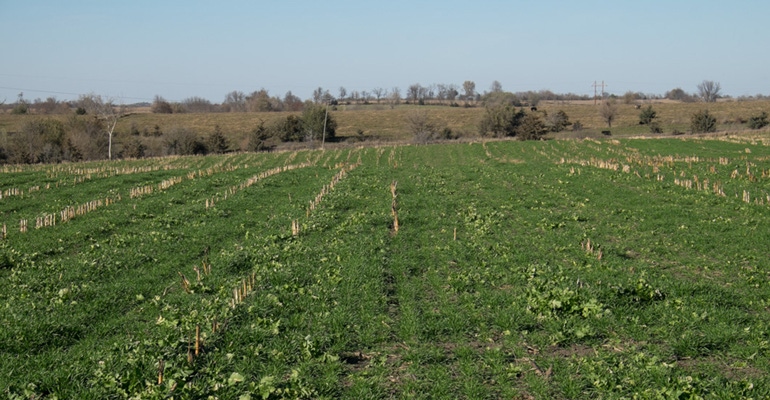
Farmers are being encouraged to plant more acres to cover crops to prevent soil erosion, and to help prevent nitrogen and phosphorus loss from farm fields. With increasing concern about water quality, more Iowa acres are being planted to cover crops after corn and soybean harvest each year for the past several years. But the practice isn’t being adopted fast enough, according to a report issued in mid-March by the Environmental Working Group (EWG) and Practical Farmers of Iowa.
The report says covers were grown on 2.6% of Iowa’s nearly 23 million acres of corn and soybeans last spring. That compares to Indiana farmers who had cover crops on 7.1% of their 11 million corn and soybean acres, and Illinois, which had covers on 2.3% of nearly 21 million acres. The report looks at three states: Iowa had 591,880 acres of cover crops; Indiana had 794,724; and Illinois 488,626 acres in covers. It’s based on satellite data looking at cover crop growth on fields between fall 2015 and spring 2016.
Farmers typically plant cover crops, such as cereal rye in the fall, to prevent soil erosion over winter and to soak up nitrogen and phosphorus during spring rains. The report says at the current pace, it could take Iowa at least three decades to reach a cover crop goal of 12.6 million acres. That goal is part of Iowa’s Nutrient Reduction Strategy, which aims to cut nitrogen and phosphorus losses that leave the state and contribute to the dead zone in the Gulf of Mexico.
More farmers are adopting use of covers
“The trend shows that more and more farmers are adopting this simple practice of planting cover crops to protect water quality, which is welcome news,” says Soren Rundquist, an analyst with EWG. “Unfortunately, it’s still an uphill battle. At this rate, it will take decades to achieve enough use of cover crops to make a real difference. That’s too long to wait.”
The report matches early state cover crop cost-share information with recent satellite data. It shows 40% of Iowa farmers continued growing cover crops without state financial incentives. However, 60% of Iowa farmers appear to have stopped using cover crops once the financial support ended the report says, although it does note that farmers could have used federal assistance.
Iowa Secretary of Agriculture Bill Northey says some of the report’s analysis is flawed. “It’s more likely many of those farmers are trying cover crops and expand the acreage, not abandon the practice,” he says. State of Iowa data indicates 75% of farmers plan to continue using cover crops. That also impacts how long it will take to reach Nutrient Reduction Strategy goals to cut nitrogen and phosphorus losses.
The groups ran three scenarios to reach 12.6 million acres of cover crops: With $10.6 million in existing state and federal funding, it would take 30 years if every farmer who tries cover crops continues the practice; 40 years with 75% continued adoption; and 75 years with 40% continued use. Northey says, “It has never been our intention to cost-share all the cover crop acres in Iowa. “Our approach is to help farmers get started with the practice and learn how it can work on their farm.”
Should funding be shifted from crop insurance?
EWG and PFI recommend shifting some funding from crop insurance programs to more cost-share for adding cover crops. For example, Iowa farmers received about $1 billion in crop insurance premium support and in crop failure payments in 2015. Northey opposes efforts to take support from crop insurance. “The federal crop insurance program is too important to farmers and should not be undermined,” he says. The report does show the need for sustained funding for water quality efforts. Several proposals are being discussed in the Iowa Legislature.
The Iowa Farm and Rural Life Poll, conducted by Iowa State University in 2016, covered issues such as conservation practice use changes in farming practices since the implementation of the Iowa Nutrient Reduction Strategy in 2013. A summary of the report is available online at store.extension.iastate.edu/Product/15093.
Northey says, “The Iowa Farm and Rural Life Poll is a great tool to gauge what farmers are thinking and I appreciate the continued focus by the poll on conservation and water quality efforts. I am very encouraged by a number of the results that show farmers increasingly aware of the issue and continuing to try new practices.”
He adds, “It is encouraging that 20% of the poll respondents used cover crops in 2015 and 33% said they might use them in the future, especially compared to the number of farmers using cover crops just a few years ago. It also shows the potential for significant growth in acreage of cover crops. In many cases farmers are trying cover crops on a limited acreage and then starting to expand that as they become more familiar with the practice and better understand how it fits into their farm operation. We all recognize we still have a lot of work to do, but the engagement by Iowa farmers and their willingness to make investments to better protect water quality is very encouraging.”
About the Author(s)
You May Also Like




